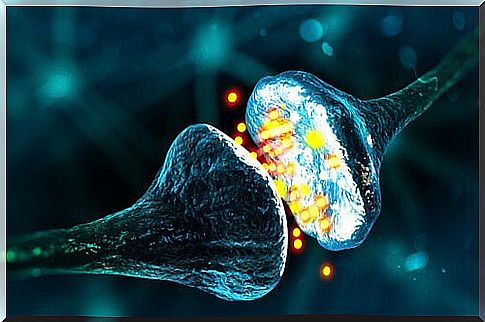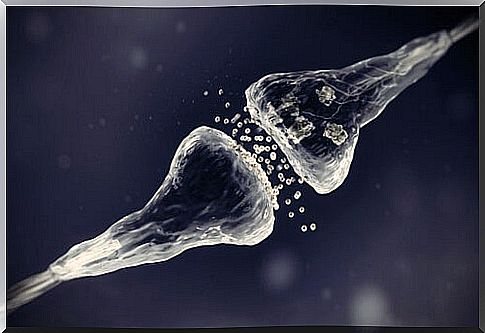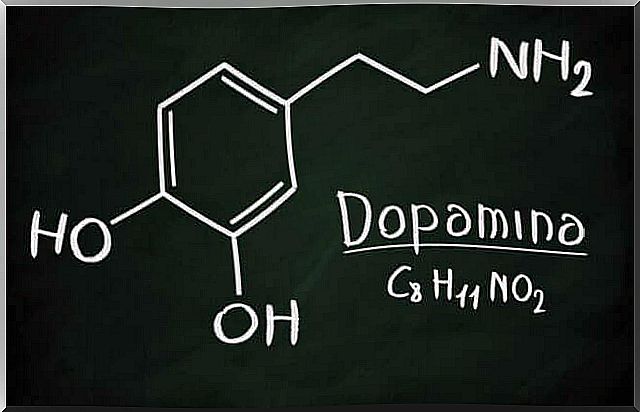The Main Neurotransmitters: What Happens When We Lack Them?

Before talking about the main neurotransmitters, let’s see what a neurotransmitter is. A neurotransmitter is a biomolecule that transmits information from one neuron to another consecutive neuron, linked by a synapse. In other words, a neurotransmitter is a chemical that is responsible for transmitting signals from one neuron to the next. Without neurotransmitters, there would be no chemical connection between neurons.
The neurotransmitter is released by synaptic vesicles at the tip of the presynaptic neuron. This occurs during the propagation of the nerve impulse. Then, it crosses the synaptic space and acts by changing the action potential in the next neuron (postsynaptic neuron), attaching itself to precise points on its plasma membrane.
Neurotransmitters guide our lives
Neurotransmitters allow us to understand the association between nervous system activation and behavior. They are not only important for the preservation of vital functions of the body. Having a deficiency or an excess of some neurotransmitter can produce disorders on different levels.

So far it has been discovered that around fifty chemicals can act as neurotransmitters. Many biopsychologists believe that several dozen more will be discovered over time. In addition, there is evidence to suggest that at least one neurotransmitter can be produced in the form of nitric oxide. Nitric oxide is a gas that, unlike the others, is in a liquid state.
Neurotransmitters guide our lives because they excite or inhibit neurons to varying degrees and at varying concentrations. The same neurotransmitter can activate a neuron when it is secreted in a certain part of the brain or inhibit its activity when it is produced in another part.
What are the main neurotransmitters?
We could safely affirm that the main neurotransmitters are the following: acetylcholine (ACH), dopamine (DA), enkephalins and endorphins, gamma-amino butyric acid (GABA), norepinephrine (NE) and serotonin (5-HT) . These molecules are essential for the body’s functions.
Acetylcholine (ACH)
Thus, one of the main neurotransmitters is acetylcholine (ACH). ACH produces contractions of skeletal muscles. For example, the venom of the black widow spider produces a continuous secretion of ACH. This causes the victim to die between muscle spasms.
ACH is also associated with the drug curare. This drug was used in the tips of poisoned darts thrown by Indians in some regions of South America. Curare prevents ACH from reaching receptor cells, paralyzing skeletal muscles and causing death by suffocation.
Gamma-Amino Butyric Acid (GABA)
GABA is another important neurotransmitter and is located in both the brain and the spinal cord. It appears to be the main inhibitory neurotransmitter in the nervous system.
This neurotransmitter is responsible for moderating a wide variety of behaviors. These behaviors range from eating to being aggressive, for example. The deadly poison strychnine causes seizures by disturbing the transmission of GABA at the synapse.
On the other hand, tranquilizers like Valium are effective since they allow GABA to work more efficiently. The same goes for alcohol.
Dopamine (DA)
Dopamine has an inhibitory effect on some neurons and an excitatory effect on others, such as those in the heart. The discovery that certain drugs can significantly affect dopamine secretion has led to the development of effective treatments for different diseases.
For example, Parkinson’s disease appears to be caused by insufficient dopamine in the brain. Drugs have been developed to stimulate dopamine production, which in many patients has proven to be very effective in reducing symptoms.

Endorphins
Endorphins are chemicals produced by the body that interact with a specific neuron, which is called the opioid receptor. Opioid receptors work to reduce the sensation of pain. In fact, many drugs, such as morphine, are used to activate opiate receptors.
People who suffer from diseases that cause severe pain, in the long term usually generate high concentrations of endorphins in their brain. This phenomenon would be the proof that the body makes an effort to control the sensation of pain.
Serotonin (5-HT)
Serotonin, commonly known as the happiness hormone, is a chemical produced by the human body that functions as a neurotransmitter. Serotonin transmits signals between the nerves. 5-HT is one of the main neurotransmitters in our nervous system.
Some researchers consider it responsible for keeping our mood in balance. Serotonin deficiency could sometimes lead to depression.
Norepinephrine (NE)
NE is a catecholamine with multiple physiological and homeostatic functions that can act as a hormone and as a neurotransmitter. One of the most important functions of norepinephrine is its role as a neurotransmitter.
Norepinephrine is released from sympathetic neurons affecting the heart. An increase in the levels of norepinephrine in the sympathetic nervous system increases the rate of contractions.
Along with epinephrine, norepinephrine is also characteristic of the fight or flight reaction, stimulating the work of the cardiovascular system. Thus, it triggers the release of glucose from energy stores, and increases blood flow to the muscles.
As we have seen, these are the main neurotransmitters. There are many more, but these are the most important. Each one performs very important functions for our survival and our functioning.









